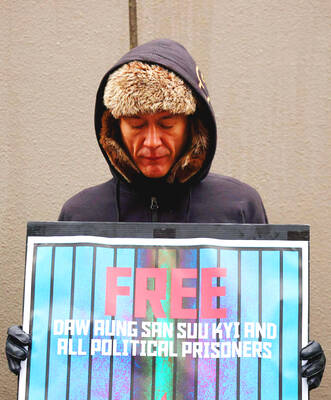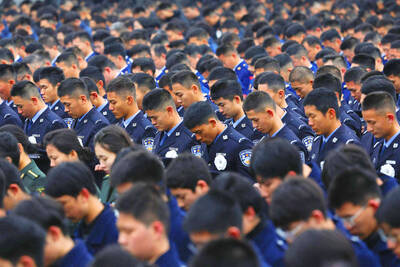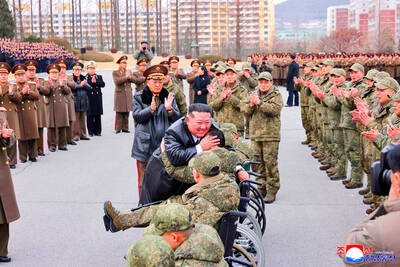The radiation leak in Japan immediately recalls memories of accidents at the Chernobyl, Ukraine, and Three Mile Island, US, power stations, and how it unfolds will be a critical test for international acceptance of nuclear energy.
The Fukushima incident, brought on by the biggest earthquake ever recorded in Japan, took a turn for the worse on Saturday after a blast blew the roof off the facility.
There are direct comparisons with the 1979 disaster at Three Mile Island in the US — in both cases a cooling fault led to a buildup of pressure in the radioactive core and resulted in a relatively small radiation leak.
Both use water to control the temperature as uranium degrades in a nuclear chain reaction at the reactors’ core, creating steam which drives a turbine to generate electricity.
The stricken Japanese reactor north of Tokyo has little parallel, however, with the Soviet plant at Chernobyl, where fundamental design faults led to a deadly series of explosions in 1986, causing hundreds of deaths among emergency workers and contamination across Ukraine and beyond throughout Europe.
Japan’s nuclear agency said the problem at Fukushima rated a four on a seven-point scale of gravity, less severe than Three Mile Island, which was a 5, and well short of Chernobyl, a full 7.
In Japan, the earthquake and possibly the following tsunami overwhelmed mains and back-up power to the coolant pumps.
At Three Mile Island in Pennsylvania, human and technical error caused a confused response to a similar failure, leading to over-heating, a meltdown of the nuclear core and a write-off of the reactor. However, unlike in Chernobyl, there was no breach of a pressure vessel, the shell which insulates the heart of a reactor, nor any major radiation leak.
Comparing the problems at Fukushima with Three Mile Island, Robin Grimes, director of the Centre of Nuclear Engineering at Imperial College London, said: “There are parallel situations in terms of some of the processes that have occurred, but not parallel because in one case it was due to the safety processes in place and in this case it was natural disaster.”
In addition, he said, there was no evidence that the core at Fukushima had melted, as happened at Three Mile Island.
That would, if it happened, lead to a greater buildup of radiation within the pressure vessel. Nor was there any sign yet that inner protective shields were damaged, Grimes said.
He said an increase in radiation in the surrounding area of eight times the normal, natural level was an indication that damage to the reactor was limited so far.
The plants at Fukushima and Three Mile Island use water cooling technology in common with most nuclear reactors. Their use of water is slightly different, however.
The Japanese reactor applies heat from the nuclear reactions in the fuel rods directly to water, creating steam which drives an electricity-generating turbine. At Three Mile Island, water under pressure transfers heat to a separate system in a less direct process for producing steam.
In Chernobyl, in a safety check gone wrong, the operators deliberately prevented a shutdown of the reactor in a rapidly escalating fiasco. Runaway nuclear fission reactions created a buildup of pressure and a massive and deadly radiation leakage as explosions ripped through a too-feeble reactor shell.
Three Mile Island did not result in a serious leak, but was still damaging at the time for the reputation of nuclear power.
The Fukushima reactor dates to the early 1970s, older than many still in use, and the industry has since developed “even safer” reactors better equipped to cool naturally, Grimes said.
Opponents of nuclear power have been swift to use the problems at Fukushima to reinforce arguments that the hazards of atomic energy outweigh the benefits.
Supporters say that the ability of Japan’s dozens of reactors to survive frequent earthquakes shows their worth, particularly to countries like Japan, which lack their own reserves of oil, gas and coal.
“We must remember that there are 55 reactors in Japan and this was a huge earthquake,” said Paddy Regan, professor of Nuclear Physics at the University of Surrey near London. “As a test of the resilience and robustness of nuclear plants, it seems they have withstood the effects very well.”

The Burmese junta has said that detained former leader Aung San Suu Kyi is “in good health,” a day after her son said he has received little information about the 80-year-old’s condition and fears she could die without him knowing. In an interview in Tokyo earlier this week, Kim Aris said he had not heard from his mother in years and believes she is being held incommunicado in the capital, Naypyidaw. Aung San Suu Kyi, a Nobel Peace Prize laureate, was detained after a 2021 military coup that ousted her elected civilian government and sparked a civil war. She is serving a

China yesterday held a low-key memorial ceremony for the 1937 Nanjing Massacre, with Chinese President Xi Jinping (習近平) not attending, despite a diplomatic crisis between Beijing and Tokyo over Taiwan. Beijing has raged at Tokyo since Japanese Prime Minister Sanae Takaichi last month said that a hypothetical Chinese attack on Taiwan could trigger a military response from Japan. China and Japan have long sparred over their painful history. China consistently reminds its people of the 1937 Nanjing Massacre, in which it says Japanese troops killed 300,000 people in what was then its capital. A post-World War II Allied tribunal put the death toll

‘NO AMNESTY’: Tens of thousands of people joined the rally against a bill that would slash the former president’s prison term; President Lula has said he would veto the bill Tens of thousands of Brazilians on Sunday demonstrated against a bill that advanced in Congress this week that would reduce the time former president Jair Bolsonaro spends behind bars following his sentence of more than 27 years for attempting a coup. Protests took place in the capital, Brasilia, and in other major cities across the nation, including Sao Paulo, Florianopolis, Salvador and Recife. On Copacabana’s boardwalk in Rio de Janeiro, crowds composed of left-wing voters chanted “No amnesty” and “Out with Hugo Motta,” a reference to the speaker of the lower house, which approved the bill on Wednesday last week. It is

FALLEN: The nine soldiers who were killed while carrying out combat and engineering tasks in Russia were given the title of Hero of the Democratic People’s Republic of Korea North Korean leader Kim Jong-un attended a welcoming ceremony for an army engineering unit that had returned home after carrying out duties in Russia, North Korean state media KCNA reported on Saturday. In a speech carried by KCNA, Kim praised officers and soldiers of the 528th Regiment of Engineers of the Korean People’s Army (KPA) for “heroic” conduct and “mass heroism” in fulfilling orders issued by the ruling Workers’ Party of Korea during a 120-day overseas deployment. Video footage released by North Korea showed uniformed soldiers disembarking from an aircraft, Kim hugging a soldier seated in a wheelchair, and soldiers and officials